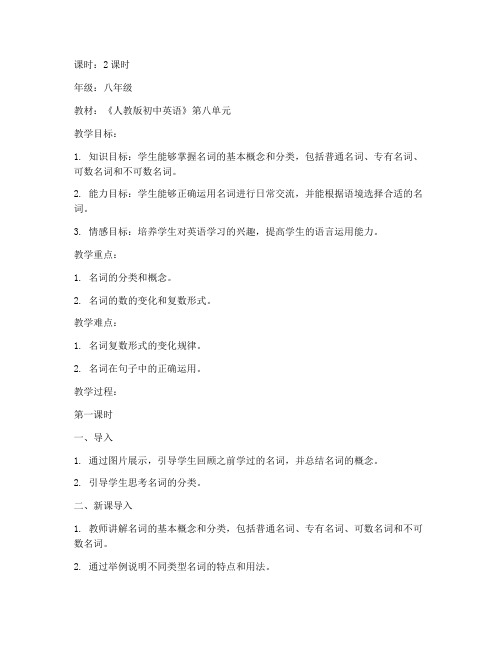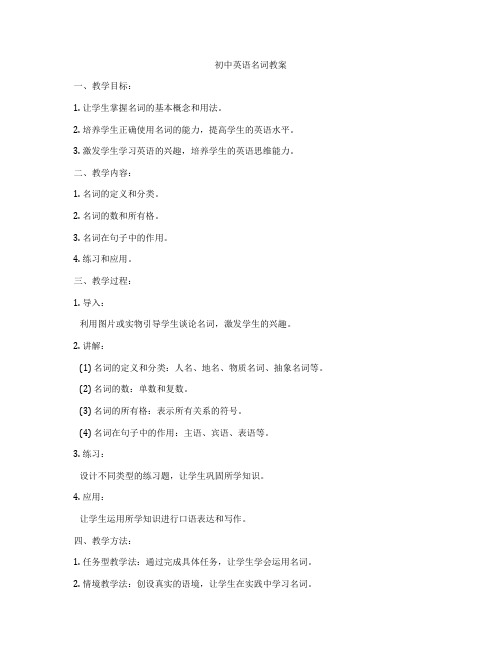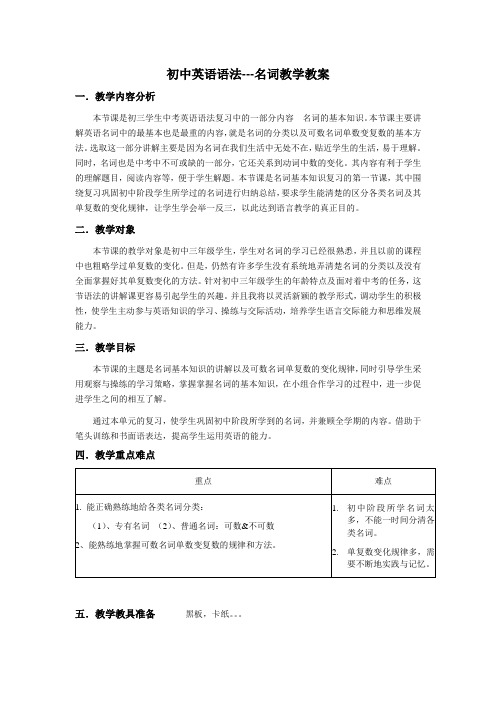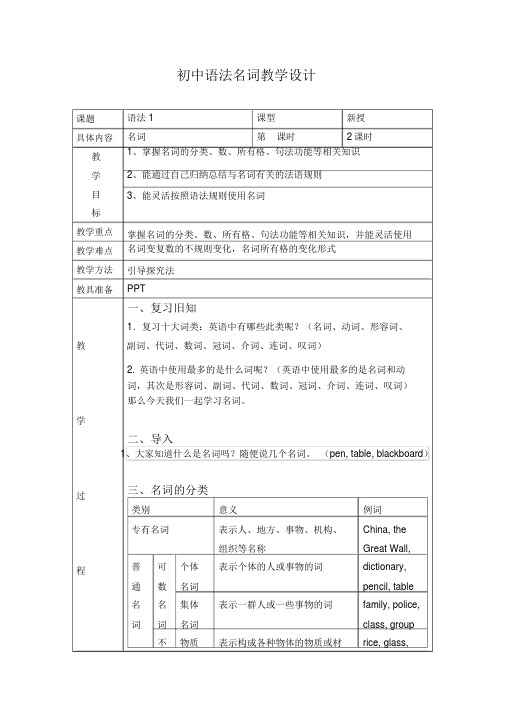初中英语语法名词教案
初中英语语法大全(教案)

初中英语语法大全(教案)第一章:名词一、教学目标1. 掌握名词的分类:可数名词、不可数名词、名词所有格。
2. 学会名词的复数形式变化规则。
3. 能够正确运用名词构成句子。
二、教学内容1. 名词的分类及特点。
2. 名词的复数形式变化规则。
3. 名词在句子中的作用。
三、教学步骤1. 引入名词的概念,让学生举例说明。
2. 讲解名词的分类及特点,引导学生进行区分。
3. 教授名词的复数形式变化规则,进行实例演示。
4. 练习运用名词构成句子,纠正错误。
四、课后作业1. 复习名词的分类及特点。
2. 练习名词的复数形式变化。
3. 运用名词写句子,加强理解。
第二章:代词一、教学目标1. 掌握代词的分类:人称代词、物主代词、反身代词、指示代词、不定代词。
2. 学会代词的用法及注意事项。
3. 能够正确运用代词构成句子。
二、教学内容1. 代词的分类及特点。
2. 代词的用法及注意事项。
3. 代词在句子中的作用。
三、教学步骤1. 引入代词的概念,让学生举例说明。
2. 讲解代词的分类及特点,引导学生进行区分。
3. 教授代词的用法及注意事项,进行实例演示。
4. 练习运用代词构成句子,纠正错误。
四、课后作业1. 复习代词的分类及特点。
2. 练习代词的用法及注意事项。
3. 运用代词写句子,加强理解。
第三章:形容词和副词一、教学目标1. 掌握形容词和副词的分类及特点。
2. 学会形容词和副词的比较级和最高级形式变化。
3. 能够正确运用形容词和副词构成句子。
二、教学内容1. 形容词和副词的分类及特点。
2. 形容词和副词的比较级和最高级形式变化规则。
3. 形容词和副词在句子中的作用。
三、教学步骤1. 引入形容词和副词的概念,让学生举例说明。
2. 讲解形容词和副词的分类及特点,引导学生进行区分。
3. 教授形容词和副词的比较级和最高级形式变化规则,进行实例演示。
4. 练习运用形容词和副词构成句子,纠正错误。
四、课后作业1. 复习形容词和副词的分类及特点。
初中英语语法名词教案

初中英语语法——名词教案教学目标:1. 让学生掌握名词的分类和用法。
2. 培养学生正确运用名词进行表达的能力。
3. 提高学生对英语语法的兴趣和自信心。
教学内容:1. 名词的分类:可数名词、不可数名词、专有名词。
2. 名词的复数形式。
3. 名词所有格的用法。
教学步骤:一、导入(5分钟)1. 老师向学生介绍本节课的主题:名词。
2. 学生通过思考和讨论,分享他们对名词的了解。
二、讲解(15分钟)1. 老师讲解名词的分类:可数名词、不可数名词、专有名词。
2. 老师举例说明名词的复数形式的变化规则。
3. 老师讲解名词所有格的用法,并通过例句进行演示。
三、练习(10分钟)1. 学生完成一份关于名词的练习题,检验自己对名词的理解。
2. 老师挑选几位学生的练习进行点评,纠正错误并讲解原因。
四、小组活动(10分钟)1. 学生分成小组,讨论并总结名词的用法。
2. 每个小组选一位代表进行汇报,其他小组成员补充。
五、总结(5分钟)1. 老师引导学生回顾本节课所学内容,总结名词的分类、复数形式和所有格的用法。
2. 学生分享自己在课堂上的收获和感受。
教学评价:1. 通过课后作业和测试,检查学生对名词知识的掌握程度。
2. 观察学生在课堂上的参与度和小组活动中的表现,评估他们的学习效果。
六、案例分析与应用(10分钟)1. 老师展示一些含有名词的句子,让学生识别并解释其中的名词。
2. 学生分析句子中名词的作用和语法功能。
3. 老师引导学生运用所学知识,分析并解决实际生活中的名词用法问题。
七、拓展训练(10分钟)1. 学生完成一份关于名词的拓展练习,巩固所学知识。
2. 老师挑选几位学生的练习进行点评,纠正错误并讲解原因。
3. 老师鼓励学生多进行名词的练习,提高自己的语法水平。
八、课堂小结(5分钟)1. 老师引导学生回顾本节课的学习内容,总结名词的分类、复数形式和所有格的用法。
2. 学生分享自己在课堂上的收获和感受。
九、课后作业(布置作业)1. 学生完成一份关于名词的课后作业,巩固所学知识。
语法名词教案模板范文

课时:2课时年级:八年级教材:《人教版初中英语》第八单元教学目标:1. 知识目标:学生能够掌握名词的基本概念和分类,包括普通名词、专有名词、可数名词和不可数名词。
2. 能力目标:学生能够正确运用名词进行日常交流,并能根据语境选择合适的名词。
3. 情感目标:培养学生对英语学习的兴趣,提高学生的语言运用能力。
教学重点:1. 名词的分类和概念。
2. 名词的数的变化和复数形式。
教学难点:1. 名词复数形式的变化规律。
2. 名词在句子中的正确运用。
教学过程:第一课时一、导入1. 通过图片展示,引导学生回顾之前学过的名词,并总结名词的概念。
2. 引导学生思考名词的分类。
二、新课导入1. 教师讲解名词的基本概念和分类,包括普通名词、专有名词、可数名词和不可数名词。
2. 通过举例说明不同类型名词的特点和用法。
三、课堂练习1. 学生根据教师提供的句子,选择合适的名词填空。
2. 学生根据教师提供的图片,用名词描述图片内容。
四、课堂小结1. 教师总结本节课所学的名词分类和概念。
2. 学生复述名词的分类和概念。
五、布置作业1. 完成课后练习题,巩固所学知识。
2. 预习下一节课的内容。
第二课时一、复习导入1. 复习上节课所学的名词分类和概念。
2. 学生回答问题,检查对名词分类的掌握程度。
二、新课讲解1. 教师讲解名词复数形式的变化规律,包括规则变化和不规则变化。
2. 通过举例说明不同名词的复数形式。
三、课堂练习1. 学生根据教师提供的句子,将名词变为复数形式。
2. 学生根据教师提供的图片,用名词的复数形式描述图片内容。
四、课堂小结1. 教师总结本节课所学的名词复数形式的变化规律。
2. 学生复述名词复数形式的变化规律。
五、布置作业1. 完成课后练习题,巩固所学知识。
2. 预习下一节课的内容。
教学反思:1. 本节课通过图片、例子等多种形式,帮助学生理解和掌握名词的分类和概念。
2. 在课堂练习中,注重学生的实际运用,提高学生的语言表达能力。
名词语法英文版教案

名词语法英文版教案(总24页) -CAL-FENGHAI.-(YICAI)-Company One1-CAL-本页仅作为文档封面,使用请直接删除名词语法英文版教案【篇一:初中英语语法教案大全】初中英语语法大全名词(一)概述名词是表示人、地方、事物或抽象概念名称的词,可以说名词是万物之名称。
它们可以是:人的名字 li ming, tom 地方名称 china, london 职业称呼 teacher, doctor物品名称 pencil, dictionary 行为名称 study, invention抽象概念history, grammar(二)普通名词和专有名词1.普通名词凡不属于特定的人名、地名、事物名称或概念名称的名词,都属于普通名词。
这类名词在所有的名词中占绝大多数。
普通名词大致有以下四种类型:1)个体名词个体名词指作为个体而存在的人或物。
可以指具体的人或物,例如:他有两个姑姑。
多数教室里都有电脑。
也可指抽象东西,例如: we?ve lived here for twenty years. 我们在这里住了二十年了。
我昨晚做了一个梦。
个体名词有复数形式,如:weeks, problems;单数形式可以和a/an 连用,如:a week, a problem, an old man.2)集体名词集体名词表示由个体组成的集体,下面是一些常见的集体名词:family(家,家庭) army(军队) company(公司;全体船员)enemy(敌人) government(政府) group(小组,团体) public (公众) team(队;组) police(警方)集体名词有时作单数看待,有时作复数看待。
一般说来,视为整体时作单数看待,想到它的成员时有的集体名词通常用作单数,例如:我们公司将派他去柏林工作。
有的集体名词多作复数看待。
例如:警察正在找他。
3)物质名词物质名词指无法分为个体的东西,我们学过的常见的物质名词有:beer, cloth, coal, coffee, coke, cotton, ice, ink, jam, juice, meat, medicine, metal, milk, oil paper, rain, salad, salt, sand, snow, soup, steel, sugar, tea, water, wine, wood, wool等。
初中英语语法名词教案

初中英语语法——名词教案教学目标:1. 让学生掌握名词的分类和基本用法。
2. 培养学生正确运用名词进行表达的能力。
3. 提高学生对英语语法的兴趣和自信心。
教学内容:第一章:名词概述1.1 名词的定义1.2 名词的分类1.3 名词的数第二章:名词的格2.1 名词的单数格2.2 名词的双数格2.3 名词的复数格第三章:名词的所有格3.1 名词所有格的规则3.2 名词所有格的用法3.3 名词所有格与of结构的区别第四章:名词的修饰语4.1 形容词作定语4.2 副词作定语4.3 介词短语作定语第五章:名词的搭配关系5.1 名词与形容词的搭配5.2 名词与动词的搭配5.3 名词与介词的搭配教学过程:一、导入(5分钟)1. 引导学生回顾已学的词汇,如动物、植物、家庭成员等。
2. 提问:这些词汇在句子中是如何使用的?二、讲解(20分钟)1. 第一章:介绍名词的定义、分类和数。
a. 举例说明名词的分类:人物名词、地点名词、物质名词等。
b. 讲解名词的数:单数和复数。
c. 练习:填空、选择题。
2. 第二章:讲解名词的格。
a. 单数格、双数格和复数格的表示方法。
b. 举例说明名词格的变化规律。
c. 练习:填空、选择题。
3. 第三章:介绍名词的所有格。
a. 讲解名词所有格的规则。
b. 举例说明名词所有格的用法。
c. 对比名词所有格与of结构的区别。
d. 练习:填空、选择题。
4. 第四章:讲解名词的修饰语。
a. 介绍形容词、副词和介词短语作定语的用法。
b. 举例说明不同修饰语对名词的影响。
c. 练习:填空、选择题。
5. 第五章:讲解名词的搭配关系。
a. 举例说明名词与形容词、动词、介词的搭配。
b. 引导学生注意名词搭配的重要性。
c. 练习:填空、选择题。
三、练习(15分钟)1. 根据所学的知识点,完成练习题。
2. 学生互相批改,教师讲解答案。
四、总结(5分钟)1. 回顾本节课所学的内容。
2. 提问:名词在句子中的作用是什么?3. 提醒学生注意名词的搭配和修饰语的使用。
初中英语名词教案

初中英语名词教案一、教学目标:1. 让学生掌握名词的基本概念和用法。
2. 培养学生正确使用名词的能力,提高学生的英语水平。
3. 激发学生学习英语的兴趣,培养学生的英语思维能力。
二、教学内容:1. 名词的定义和分类。
2. 名词的数和所有格。
3. 名词在句子中的作用。
4. 练习和应用。
三、教学过程:1. 导入:利用图片或实物引导学生谈论名词,激发学生的兴趣。
2. 讲解:(1) 名词的定义和分类:人名、地名、物质名词、抽象名词等。
(2) 名词的数:单数和复数。
(3) 名词的所有格:表示所有关系的符号。
(4) 名词在句子中的作用:主语、宾语、表语等。
3. 练习:设计不同类型的练习题,让学生巩固所学知识。
4. 应用:让学生运用所学知识进行口语表达和写作。
四、教学方法:1. 任务型教学法:通过完成具体任务,让学生学会运用名词。
2. 情境教学法:创设真实的语境,让学生在实践中学习名词。
3. 互动式教学法:鼓励学生积极参与,提高学生的学习积极性。
五、教学评价:1. 课堂参与度:观察学生在课堂上的发言和表现。
2. 练习正确率:检查学生完成练习题的正确率。
3. 应用能力:评估学生在口语表达和写作中的运用能力。
六、教学资源:1. 图片或实物:用于引导学生谈论名词。
2. 练习题:用于巩固所学知识。
3. 教学课件:辅助讲解和展示名词的相关知识。
七、教学时间:1课时(40分钟)八、课后作业:1. 复习名词的基本概念和用法。
2. 完成课后练习题。
3. 尝试在日常生活和学习中运用所学知识。
通过本节课的教学,使学生掌握名词的基本概念和用法,提高学生正确使用名词的能力,为后续学习打下基础。
同时,注重培养学生的英语思维能力,激发学生学习英语的兴趣。
初中英语语法---名词教学教案

初中英语语法---名词教学教案一.教学内容分析本节课是初三学生中考英语语法复习中的一部分内容---名词的基本知识。
本节课主要讲解英语名词中的最基本也是最重的内容,就是名词的分类以及可数名词单数变复数的基本方法。
选取这一部分讲解主要是因为名词在我们生活中无处不在,贴近学生的生活,易于理解。
同时,名词也是中考中不可或缺的一部分,它还关系到动词中数的变化。
其内容有利于学生的理解题目,阅读内容等,便于学生解题。
本节课是名词基本知识复习的第一节课,其中围绕复习巩固初中阶段学生所学过的名词进行归纳总结,要求学生能清楚的区分各类名词及其单复数的变化规律,让学生学会举一反三,以此达到语言教学的真正目的。
二.教学对象本节课的教学对象是初中三年级学生,学生对名词的学习已经很熟悉,并且以前的课程中也粗略学过单复数的变化。
但是,仍然有许多学生没有系统地弄清楚名词的分类以及没有全面掌握好其单复数变化的方法。
针对初中三年级学生的年龄特点及面对着中考的任务,这节语法的讲解课更容易引起学生的兴趣。
并且我将以灵活新颖的教学形式,调动学生的积极性,使学生主动参与英语知识的学习、操练与交际活动,培养学生语言交际能力和思维发展能力。
三.教学目标本节课的主题是名词基本知识的讲解以及可数名词单复数的变化规律,同时引导学生采用观察与操练的学习策略,掌握掌握名词的基本知识,在小组合作学习的过程中,进一步促进学生之间的相互了解。
通过本单元的复习,使学生巩固初中阶段所学到的名词,并兼顾全学期的内容。
借助于笔头训练和书面语表达,提高学生运用英语的能力。
四.教学重点难点五.教学教具准备黑板,卡纸。
六.教学方法1. “Communicative” Approach(交际教学法),2.“Task-based” language teaching (任务教学法).七.教学步骤1.导入(warm-up)(1 min)师生之间相互问候,从周围的食物引出本节内容。
初中英语语法名词教案

初中语法名词教学设计课题具体内容教学目标教学重点教学难点教学方法教具准备语法1课型新授名词第课时2课时1、掌握名词的分类、数、所有格、句法功能等相关知识2、能通过自己归纳总结与名词有关的法语规则3、能灵活按照语法规则使用名词掌握名词的分类、数、所有格、句法功能等相关知识,并能灵活使用名词变复数的不规则变化,名词所有格的变化形式引导探究法PPT一、复习旧知1.复习十大词类:英语中有哪些此类呢?(名词、动词、形容词、教副词、代词、数词、冠词、介词、连词、叹词)2.英语中使用最多的是什么词呢?(英语中使用最多的是名词和动词,其次是形容词、副词、代词、数词、冠词、介词、连词、叹词)那么今天我们一起学习名词。
学二、导入1、大家知道什么是名词吗?随便说几个名词。
(pen, table, blackboard)过三、名词的分类类别意义例词专有名词表示人、地方、事物、机构、China, the组织等名称Great Wall,程普可个体表示个体的人或事物的词dictionary,通数名词pencil, table名名集体表示一群人或一些事物的词family, police,词词名词class, group不物质表示构成各种物体的物质或材rice, glass,可名词料的词water, paper数抽象表示状态、品质、行为、感情Health, love,名名词等抽象概念的词interest教词四、可数名词的复数形式(一)名词复数构成形式的部分规则变化:情况构成方式例词一般情况加 -s cake-cakes; bed-beds以 -s,-x,-sh,-ch 等结尾的词加 -es bus-buses; box-boxes;学watch-watches 以辅音字母加 -y 结尾的词变 y 为 i, 加-es baby-babies;city-cities以元音字母加 -y 结尾的词加 -s toy-toys;monkey-monkeys 以 f(fe) 结尾的词变 f(fe) 为 ves leaf-leaves; life-lives不规则变化改变单数名词man-men;过中的元音字母woman-women;foot-feet; tooth-teeth单复数形式相fish; sheep; deer;同Chinese; Japanese其他形式mouse-mice程(二)某国人变复数1、中国人 a Chinese- Chinese2、英国人an Englishman- Englishmen3、阿拉伯人an Arab- Arabs口诀:中日不变英法变,其余s 加后面(三)以 -o 结尾的名词,有些在词尾加-es, 它们是“黑人英雄爱吃土豆”。
